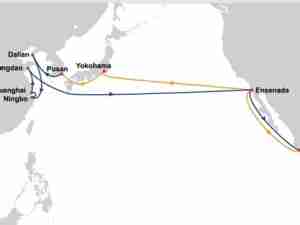Fears of food inflation and tight stocks have pushed up wheat prices, with U.S. futures reaching 29-month highs this week.
Traders said Australia was poised to sell feed quality grain in Europe for the first time in decades filling a shortfall caused by a decline in exports from Russia, which suffered its worst drought last year in more than a century.
The quality of Australia's latest wheat crop has been degraded by persistent rains and flooding, meaning one of the world's biggest exporters of milling wheat has large amounts of feed grain on its hands.
Freight players said any pick up in demand for Australian grains shipments to Europe would support earnings for smaller vessels such as panamaxes, which are typically used to transport grain cargoes from there, as well as smaller supramaxes.
"The expectation is that the second and third quarters could see a boost in activity on the smaller classes of ships especially on the supramaxes, handies and panamaxes," said Peter Sand, shipping analyst with ship association BIMCO.
"If the Australians beef up their grains exports to Europe, that will add to the tonne miles and help support freight rates further. We could see competition for ships given that the South America grains season also picks up in the second quarter."
Ton miles are a key indicator of shipping demand, measuring transported cargo volume multiplied by distance.
"This could give a boost to the panamaxes in the short-term," a trade source said.
Pirate Gangs
Shipping sources have said grains shipments are being diverted around Africa as Somali pirate gangs strike deeper at sea increasing journey times and potentially lifting insurance costs at a time of unrest over food prices.
"A day does not go by without there being a firefight between merchant ships and pirates in the Gulf of Aden," said Sand. "So increasingly that area is becoming a higher risk for ship owners and crew on board merchant vessels and will probably lead to more vessels re-routing around the Cape of Good Hope."
The Baltic dry freight index, which tracks rates to ship dry commodities, has slumped to its lowest in nearly two years in recent days as the market struggles to absorb a glut of ships ordered before economic turmoil in 2008.
Average panamax rates have slid to just under $11,000 a day this week for the first time since early 2009, compared with over $90,000 a day in before the global crisis in 2008.
"Demand for bulk carrier services has been hit by the natural disaster in Australia and weakened the tonnage balance, coming at the worst of times when the fleet is growing at an unprecedented rate," said Nicolai Hansteen, chief economist with Lorentzen & Stemoco.
Fleet Growth
While Australia, one of the world's biggest exporters, ramps up feed quality grain shipments, higher grade wheat export availability will be lower due to excessive harvest rains.
Shipping sources said higher quality Australian exports will need to be covered by other origins such as Argentina and the United States.
"While the overall quantity of grain exports is not expected to be up meaningfully, supply disruptions should make the distance the crops have to travel longer this year," FBR Capital Markets analyst Doug Garber said in a report this week.
"Asian economies, which account for roughly a third of grain imports, might need to import from longer-haul exporters such as the U.S. or even Argentina."
But brokers and analysts say even with the potential pick up in activity, fleet growth was set to weigh on the overall dry bulk sector.
"Disrupted harvests are creating a short-term effect -- that does soak up some tonnage," said Mark Williams, research manager with broker Braemar Seascope. "But the effect will be quite short-lived." (Reuters)






